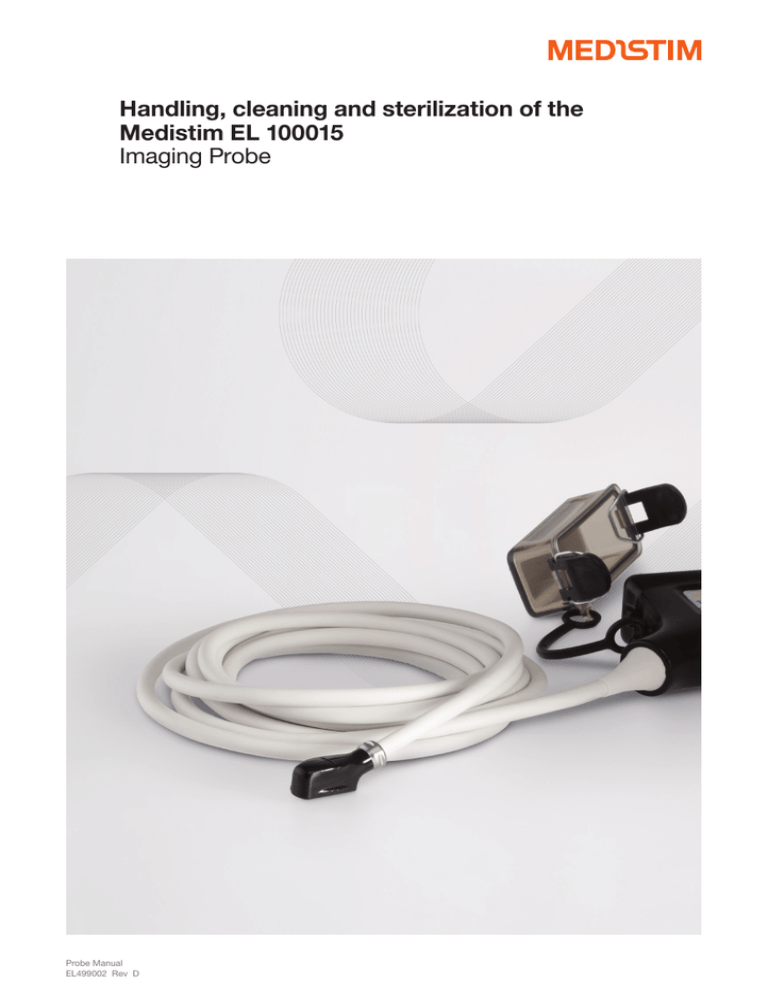Handling, cleaning and sterilization of the Medistim EL 100015
advertisement

Handling, cleaning and sterilization of the Medistim EL 100015 Imaging Probe Probe Manual EL499002 Rev D The purpose of this procedure is to guarantee that the probe performance is in accordance with the specifications during the entire life cycle of the probe. The probes are warranted against manufacturing defects for one year or 100 sterilization cycles, whatever comes first. 1 HANDLING The Medistim probes are delicate high precision instruments and should be handled with care. Damage to the probe can compromise patient safety, reduce image quality, and cause measurement inaccuracies. A probe that is handled with care will last longer and give better performance. Please note the following: • Do not stretch the cable. • Use care when coiling the probe cable and make sure it is laid in large loops. Avoid tight wrapping around the palm of the hand. • Use care when cleaning the probe. • Clean the probe immediately after use. Avoid blood to dry on the probe surface. • Use care and avoid cutting or pinching the cable with sharp tools. • It is highly recommended that the probe’s original packaging is to be used during shipment, handling, and storage. • Note that probes with damage due to careless handling will not be covered by the warranty. 2 CHECKS FOR MECHANICAL INTEGRITY Prior to use and during the cleaning process, check each probe for mechanical integrity. The probes are delicate medical devices that may experience mechanical abrasion, which could damage them. Probes that show external signs of abrasion (visible cracks, small cuts in the probe cable, etc.) should be checked for electrical safety (see section 3 or returned to Medistim for evaluation). Probes with major mechanical malfunctions should not be used and should be replaced. Please contact your local representative or Medistim directly. 3 CLEANING Automatic washing machine: Wear protective gloves when removing the probe from the sterile field and when cleaning, as it may be stained with blood. The probe can be cleaned in a low temperature automatic washing machine under the following conditions: 1. After use and prior to any cleaning, attach connector cap and ensure latches are locked on both sides. 2. Washing temperature of maximum 65°C 3. Use non-aggressive detergents 4. Drying temperature of maximum 65°C Manual cleaning: Wear protective gloves when removing the probe from the sterile field and when cleaning, as it may be stained with blood. 1. After use and prior to any cleaning, attach connector cap and ensure latches are locked on both sides. 2. Immerse the probe and soak for a minimum of five (5) minutes in a fresh, pH-neutral, enzymatic cleaning solution per the manufacturer’s instructions. 3. Use a soft-bristled brush moistened with cleaning solution to remove all traces of debris. Pay close attention to crevices, matted surfaces, and any hard-to-reach areas. 4. Thoroughly rinse the probe under running warm (30-43°C) tap water until visibly clean. 5. Wipe the probe with 70% isopropyl alcohol (IPA) before sterilization. 6. Check probe for any remaining debris and repeat cleaning procedure if necessary. ATTACH THE CONNECTOR CAP TO MAKE SURE FLUIDS DO NOT ENTER THE PROBE CONNECTOR DURING CLEANING AND DISINFECTION. Probe Manual EL499002 Rev D 4 ELECTRICAL LEAKAGE CURRENT TEST The EL100015 probe has been validated to withstand 100 autoclave cycles without the electrical patient insulation being compromised or weakened. After 100 cycles, a manual electrical leakage current test is required for continued electrical safety. The VeriQ C system will alarm the operator when the probe needs to be tested. Next time the same probe is connected to the system, the operator will be asked to confirm that the probe has passed the test after last use. The test can be easily performed using an ultrasound probe electrical test system during disinfection of the probe after use, as illustrated in Figure 1. This test setup is identical to the test setup prescribed for the electrical test of trans-oesophageal ultrasound probes established as a standard procedure in the market. A suggested set up is described in Section 7. 250 mm Probe adapter Figure 1 - Ultrasound probe electrical current leakage test setup. Medistim also recommends electrical safety test prior to 100 times use as part of the inspection procedure described in section 2, as the integrity of the insulation material cannot always be confirmed by visual inspection alone. Test procedure of EL100015 probe: 1.Submerge a 250 mm length of the probes’ nosepiece and cable, measured from the probe tip. 2.Connect the probe connector to the probe adapter of the test system. 3.Perform the prescribed conductivity test ensuring that the electrical conductivity in the fluid used in the soak tray is sufficient for the testing to be done correctly. 4.Perform the probe leakage current test. 5.Note, procedural details may vary, depending on the type of test equipment used. Make sure you consult the test systems’ operator manual. 5 DISINFECTION (Not required / not recommended) The methods described in section 3 & 6 will render the probe terminally sterilized and disinfection is neither required nor recommended by Medistim as this may cause damage to the probe. If disinfection is performed regardless, please follow the manufacturers’ instructions for use closely. WARNING: DAMAGES DUE TO USE OF DISINFECTION SOLUTIONS ARE NOT COVERED BY THE WARRANTY. 6 STERILIZATION Medistim has validated the following sterilization method for the Medistim EL-probe EL100015: Sterrad® Sterilization (a process described by Johnson &Johnson). The Sterrad® system is a rapid, low-temperature and low-moisture technology designed for delicate instrument sterilization. The following models can be used to sterilize the Medistim EL100015 probe: • Sterrad® NX • Sterrad® 100S • Sterrad® 100NX • Sterrad® 200 WARNING: UNLOCK LATCHES AND REMOVE THE CAP FROM THE CONNECTOR DURING STERILIZATION. Probe Manual EL499002 Rev D The sterilization cycle involves the following steps: 1. Follow instructions for use for the Johnson &Johnson sterilization process to protect the probe from accidental damage during handling. 2. Clean the probe as described in Section 3 and dry thoroughly. 3. Remove cap from the connector. 4. Place the dry probe in a Sterrad® instrument tray and double wrap tray in CSR wrap. 5. Place the instrument tray(s) in the sterilization chamber according to manufacturer’s loading instructions and close the chamber door. Start pre-programmed sterilization cycle per manufacturer’s instructions. 6. The probe is ready for use after the sterilization cycle is complete. Normal cycle time is 28 75 minutes depending on the model. WARNING: STEAM AUTOCLAVE STERILIZATION WILL DESTROY THE MEDISTIM ELPROBE AND IS NOT COVERED BY THE WARRANTY. 7 TEST EQUIPMENT FOR ELECTRICAL LEAKAGE CURRENT TESTING A typical test system for electrical leakage currents of ultrasound probes includes the following items; a) a soaking tray, b) an adapter for the ultrasound probe being tested, c) a dual electrode and d) a test unit capable of setting up the correct voltages for the testing as well as checking the electrical conductivity of the liquid used for immersing the probe. The liquid can be normal saline solution (9g NaCl /litre H2O) or any conducting disinfection liquid such as CidexTM. A typical test system is shown in Figure 1. If you already have test equipment set up for trans-oesophageal probes, the same equipment can be used for testing the EL100015 probe, provided the correct probe adapter is used: A 260 pin Tyco Electronics miniaturized connector, like the one used on GE LogiqBook platform and Philips Medical CX50 platform. Warning: The test system must be set up and verified by qualified personnel from the Medical Technical Department according to individual hospital policy and regulations for safety testing. The EL100015 probe is defined as patient applied part type CF (Cardiac floating). The probe must meet patient leakage current requirements given in the table below. The test system should be programmed accordingly. Patient applied part type Allowed patient leakage current Test voltage CF 50μA 110% of the AC mains voltage Type Manufacturer Web Probe adapter for EL100015 ULT 800 Fluke Biomedical www.flukebiomedical.com Not available, compatible to ULT-PA-25 (see below) ULT-2000 BC Biomedical www.bcgroupintl.com ULT-PA-25 C-10 Optima Scandinavia AB www.probetester.com System specifically intended for TEE probes. Use adapter for GE LogiqBook Probe Manual EL499002 Rev D Explanation of symbols on probe- and package- labeling 0470 Conformité Européenne (European Conformity). This symbol means that the device fully complies with European Directive 93/42/EEC. “Follow instructions for use” IPX7 Protected against the effects of temporary immersion in water Quantity Date of Manufacture Manufacturer address only STERILE SN REF Caution: Federal Law (USA) restricts this device to sale by or on the order of a physician. Shipped NON-STERILE Serial Number FDA 510(k) cleared no. K102595 Catalogue number 0470 Medistim ASA (Head office) Økernveien 94 0579 Oslo Norway Phone +47 23 05 96 60 Medistim Norge AS Økernveien 94 0579 Oslo Norway Phone +47 23 03 52 50 Medistim UK 2 City Place Beehive Ring Road, Gatwick West Sussex, England Phone: +44 207 486 5888 Medistim Deutschland GmbH Bahnhofstr. 32 82041 Deisenhofen Germany Phone +49 (0) 89 62 81 90 33 Probe Manual EL499002 Rev D Medistim USA Inc. 14000 25th Ave N. Ste. 108 Plymouth, MN 55447 USA Phone +1 763 208 9852 Medistim Danmark ApS 1Gøngetoften 13 2950 Vedbæk Denmark Phone +45 2276 5669 medistim@medistim.com www.medistim.com



